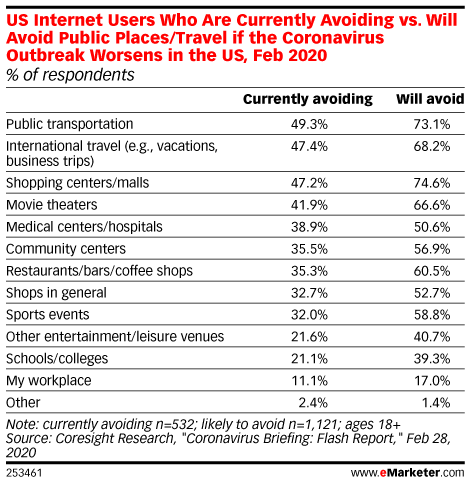The global effects of COVID-19, more commonly referred to as coronavirus, are being felt by all industries. The outbreaks have affected the stock market, the events industry (we just saw SXSW here in Austin canceled for the first time in 34 years), the travel industry, and more. Major tech companies have ordered their employees to work remotely, and schools are sending students home to take virtual classes. While the validity of the concerns is something we will leave to the pundits and Twitter, we want to take a look at the impact of coronavirus on shipping and e-commerce.
Note: this article is for informational purposes only and is not meant to provide medical advice of any sort. Please follow the guidelines provided by cdc.gov and medical professionals.
Effects on the supply chain
The first coronavirus outbreak happened near Wuhan, Hubei Province, China and has affected the ability of many employees to work in the factories located there. This has an economic impact not only locally in Wuhan, but also across the globe.
Even if you produce your own products, there’s a chance you order supplies from overseas, or your supplier orders supplies from China. When your supply chain is slowed or delayed indefinitely, you need to start considering your next steps. 44% of retailers expect product delays due to the coronavirus, and 40% expect inventory shortages, according to a Digital Commerce 360 survey.
One major impact of coronavirus on shipping is that some merchants have begun researching other suppliers to temporarily or permanently replace ones they’ve worked with who are experiencing disruptions. Some have looked to suppliers in India and other countries. Some merchants have begun researching US-based suppliers due to concerns with delayed shipping overseas, even though the cost difference will likely affect their bottom line.
In a recent interview with Klaviyo, Josh Behr, director of marketing and e-commerce at Amerex Group, had three suggestions:
I think they can still be very nimble. I’d recommend they look at three things.
First, I’d say look at your inventory position to see what you have in stock. Do you need more? If so, can you source locally, even if for a limited quantity of units, to keep things running for the next 30-60 days while things hopefully shake out overseas?
Next, I’d suggest looking at your cash flow. Make sure that if you’re spending money on advertising, you’re getting the margin or the cost per acquisition that makes sense for the business. Use channels that don’t have high acquisition costs, like email marketing, and use them to your advantage.
Then, ensure you have a remote work strategy in place. How will your team continue to communicate? Whether it’s through Slack, Asana, or email, make sure your team is continually communicating. Communication is going to be the biggest part of this whole process, and ensuring that everyone on your team is continuing to be in touch with each other during this time will help everybody keep moving forward.
One of the best ways to ensure you’re getting the lowest acquisition costs through email is to segment your audience and cater your messaging to specific groups.
Effects on the shipping industry
E-commerce depends on shipping to succeed. It’s the backbone of the industry. As automated as shipping procedures have become, there are still plenty of people involved in the process.
Reuters has reported that UPS and FedEx warned the coronavirus outbreak could disrupt the shipment of goods in affected countries. While they have not suspended operations yet, if you sell items internationally you should be paying close attention to what these and other carriers do concerning those countries.
There don’t seem to be any restrictions here in the US as of the time of this writing, and none of the carriers have suspended domestic service to affected cities. The statement from USPS (as of March 4, 2020) is as follows:
The US Postal Service is closely monitoring the coronavirus (COVID-19) situation and continues to follow strategies and measures recommended by the CDC and Public Health Department. The CDC has information available on its website, https://www.cdc.gov, that provides the latest information about the virus.
We continue to have a temporary suspension of the guarantee on Priority Mail Express International destined for China and Hong Kong, which has been effective since Monday, Feb. 10, 2020, due to widespread airline cancellations and restrictions into this area. In addition, customers may see delays in mail and packages destined to China as well as from China. The Postal Service is undertaking all reasonable measures to minimize the impact to our customers.
Regarding the importation of packages, the CDC states there is likely very low risk that COVID-19 can be spread from products or packaging shipped from China, because of poor survivability of coronaviruses on surfaces. Also, according to the CDC, there currently is no evidence to support transmission of COVID-19 associated with imported goods; and there have been no reported cases of COVID-19 in the United States associated with imported goods.
Amazon has begun informing Prime customers that there may be delivery delays as online orders increase. This is particularly true for Prime Now orders as people order more consumer-packaged goods, groceries, and supplies using the service.
As your partner in shipping, we will be closely monitoring updates from the major carriers to help keep you informed if anything changes.
Effects on e-commerce
When examining the impact of coronavirus on shipping and e-commerce, the latter aspect can be double-sided. Some industries could see major upticks, while others could experience sharp declines.
The fact of the matter is many people will be home and not purchasing products in person. People who are self-quarantined, elderly, or immune-suppressed may not be able to shop as they normally would. For those people, e-commerce will be the best viable option.
“Consumers being home more than normal could drive e-commerce sales in more specific categories like consumer product goods, grocery and staple items. Categories more prone to increase during times of physical retraction of a population are health and beauty, grocery, and consumer product goods. Short-term discretionary spending on fashion merchandise may decline while Americans look to make sure needed goods are well-stocked in their homes. ”
Now, don’t hear what we’re not saying. That doesn’t mean we’re advocating for a “coronavirus sale” email campaign targeted to people who may be stuck at home. But this would be an ideal time to really try to understand your audience demographics to glean insights into what you can expect and project from the coming months.
Approach the situation with empathy and a sense of community. It may be a great opportunity to reinforce your messaging around shopping local and supporting small businesses, especially if you’re already seeing a down-tick in orders. Even if a community can’t come together physically, they still can digitally.
Business owners in some industries may really have to nuance their marketing communications. If you sell travel accessories, for example, you may need to tailor messaging away from “travel now” and more toward “be prepared when it’s safe to travel again.”
There may be other tangential effects that online and in-store retailers will notice. For example, due to supply-chain issues, smartphone sales are expected to decline by over 20% in China for Q1 2020, compared with a 5% drop globally, according to Counterpoint Research. That also may mean that sales of smartphone accessories could see a decline as people may not be looking for new protective gear for their new, differently-sized phones. Effects like this will be worth monitoring as supply chains and in-store sales reductions affect the sales of complementary items e-commerce merchants may sell.
According to an eMarketer survey, people are already beginning to avoid public shopping centers, and will increasingly do so if they continue to see the coronavirus spread. This doesn’t just apply to the elderly or high-risk, but the general population as well.

Try to avoid downplaying the risks associated with coronavirus, as that could elicit negative responses and make you look callous, but also don’t play into fear-based marketing. Take the situation seriously while simultaneously trying to provide products your customers may still need and want during this time.
47% of retailers expect some downside in revenue due to the coronavirus, according to a survey conducted in March 2020 of 304 retailers by Digital Commerce 360. 33% of retailers say it’s too early to tell. However, a majority of retailers, 58%, say the virus will impact consumer confidence, and 22% say there will be a significant impact. Consumer confidence is often used as a measure of how consumers feel about the economy.
As it stands right now, we haven’t heard about much of an impact on our customers. We are keeping a close eye on things and are here to help however we can.
Reassure your customers
Make sure you and your employees follow all procedures recommended by the CDC. Be transparent with customers if you are experiencing delays in your supply chain or if carriers begin to report delays. Set expectations so people understand that there are extenuating factors out of your control but you’re doing your best to get them their orders as soon as you can.
Hopefully, warmer spring weather and smart policies will help reduce the spread and begin to minimize the impact of coronavirus on shipping and e-commerce. Hang in there, and try to be nimble during this tough time for e-commerce merchants and the general population alike.
E-commerce merchants always need to cut costs, even more so now. Start a 30-day free trial of ShippingEasy to save on shipping rates, get time back in your day, and ship from anywhere with a cloud-based solution.
Rob Zaleski
Latest posts by Rob Zaleski (see all)
- USPS 2023 Shipping Rate Changes - November 16, 2023
